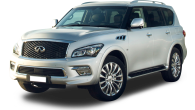There has always been something deliciously contradictory about the Audi SQ7.
Bristling with advanced technologies from a very progressive brand on one hand, it also boasted a V8 diesel with two turbos on the other. So, while there was enough torque to tow a small asteroid, the world has since started turning towards electrification.
Now, six years later, the SQ7 ditches TDI for TFSI, ushering in a new twin-turbo petrol V8. Which means weight and pollution are down and acceleration is up… but then so are prices and fuel consumption.
Audi SQ7 2023: 4.0 Tfsi Quattro
| Engine Type | Twin Turbo V8, 4.0L |
|---|---|
| Fuel Type | Premium Unleaded Petrol |
| Fuel Efficiency | 12.1L/100km (combined) |
| Seating | 7 |
| Price From | $153,230 - $176,110 |
| Safety Rating |
|
Does it represent good value for the price? What features does it come with?
8 / 10
So, what’s been up with the Q7 since the second-generation model launched in Australia in September, 2015?
Plenty. Several 3.0-litre V6 turbo-diesels have been on offer, including a short-lived e-tron that was way ahead of its time in 2017, before an extensive facelift in 2020 brought in fresh nose, tail and dashboard treatments, among a host of other improvements.
Surfacing in August, 2016, the old SQ7 TDI quattro (for all-wheel drive) featured a 320kW/900Nm 4.0-litre V8 twin-turbo diesel at its heart, resulting in a 0-100km/h sprint time of 4.9 seconds, on the way to a 249km/h top speed.
.jpg)
If that sounds a lot for a 2.5-tonne seven-seater SUV, note that the MLB Evo architecture used underneath is also the basis for the Porsche Cayenne, Bentley Bentayga and Lamborghini Urus, so there’s some pretty impressive cross-DNA goodness going on here.
Anyway, you need to factor such things in when considering the new MY23 SQ7 TFSI’s $164,100 before on-road costs.
Even with its 4.0-litre V8 twin-turbo petrol engine delivering more power (up 53kW to 373kW) but less torque (down 130Nm to 770Nm), it has managed to slash 0.8s off that 0-100km/h time (to just 4.1s), so remains a unique proposition in the marketplace. Seven people have rarely travelled so swiftly on public roads.
Too bad the TFSI averages 12.1 litres per 100km when the TDI returned just 7.6L/100km.
.jpg)
Let’s look at rival equivalents.
The US-built 390kW/750Nm BMW X7 M60i from $197,900 comes closest, but is over half a second slower to 100km/h and starts from $30,000 more. The 450kW/850Nm Mercedes-Benz GLS 63AMG 4Matic+ also from America is just as speedy but costs from around $100,000 more than the SQ7 while Britain’s new Range Rover L460 seven-seater versions are about twice the price. Advantage, Audi.
Electrification, meanwhile, is a great leveller, but the much quicker-off-the-line Tesla Model X Twin Motor is currently unavailable in Australia, while the Volvo XC90 Recharge T8 Plug-In Hybrid from just $121,990 is way off the SQ7’s performance.
Some of the Audi’s rivals include everything, helping to better justify their lofty price points.
.jpg)
The SQ7 TFSI is reasonably well equipped, but the Ingolstadt company still insists on charging extra for some items.
On the standard ledger you’ll find safety equipment like Audi pre-sense front and pre-sense rear, which includes autonomous emergency braking, cross-traffic alert and active lane-keep assistance, Matrix LED headlights, surround-view cameras, all-wheel steering, adaptive cruise control with full stop/go, eight airbags and hill-descent control.
These come on top of items such as adaptable air suspension, a 12.3-inch digital instrumentation, ‘Valcona’ leather upholstery, electrically adjustable sports front seats with heating, four-zone climate control, satellite navigation, Audi Connect Plus emergency assistance, DAB+ digital radio, premium audio with 19 speakers, wireless Apple CarPlay and Android Auto, Bluetooth telephony, ambient lighting, panoramic sunroof, rear privacy glass, soft-close doors, a powered tailgate with gesture control, heated/folding heated exterior mirrors with memory function, roof rails, metallic paint, an S body kit, paddle shifts, sports steering wheel, and 22-inch alloy wheels. A space-saver spare wheel is fitted.
However, you’ll need to pay extra for items like leather/leather-like dash inserts, suede-like headlining trim, front-seat ventilation, rear-seat heating and an audio upgrade – which are all bundled in a Sensory package at $13,300.
For another $10,900 you can also obtain the Dynamic Package, which brings a sport differential and electromechanical active roll bar, while ceramic brakes will cost you a cool $19,500.
Overall, then, the SQ7 TFSI represents decent value within its rarefied performance seven-seater SUV field.
Is there anything interesting about its design?
8 / 10
The first Audi Q7 of 2005 can be seen in several subsequent SUVs across the board – namely in the current Renault Koleos. It turned out to be quite an influential vehicle.
The current 4M series has aged remarkably well, given it’s been around since 2015, while the 2020 facelift has infused some worthwhile updates that keep the full-sized SUV looking comparatively contemporary.
With a subtle body kit and Audi Sport alloys finished in matt titanium, there’s now slightly more differentiation in the SQ7 compared to the earliest versions, helping justify the heady pricing.
Handsome and quite formal in that Germanic way, the Q7 continues to look the part. Too bad the seven-seater has such a downbeat autumnal colour palette, though.
.jpg)

How practical is the space inside?
9 / 10
Audi sure knows how to make interiors alluring – compelling, even – and the SQ7’s is no exception. This is despite the advancing years of the basic dash shape.
The basics are spot-on. Loads of space, great front seats with just the right amount of comfort and bracing support, superb ventilation and logically laid out controls. The wide centre console, solid gear lever and copious amounts of storage reveal a functionality focus underpinning all else inside. As you might expect from the brand.
That should describe most modern luxury alternatives, but the differences here are the rich look and textures, as well as the high quality fit and finishes. The big SUV manages to exude class, which is a good thing considering the cost of entry. From the diamond-patterned seat faces to the signature aromas, the Audi walks the very fine line between sophistication and ostentation.
The 2020 facelift introduced broader screen choices, with this grade gaining a variation of the A8 flagship’s split-level centre console haptic touchscreens. The upper section is the touchscreen with a 10.1-inch display for (cracking) audio, as well as multimedia and camera views, while the lower one operates several of the SUV’s functions, including the climate control system. A mish-mash of old and new design, then, it still manages to work.
Case in point: unlike many cheaper layouts, this one doesn’t require too much familiarisation. And it works well enough, though some people will certainly prefer the switches and buttons the company used to excel so brilliantly at.
Looking at the Virtual Cockpit digital display, the same also applies, though – again – Audi’s experience here as a pioneer of such tech shows, with various viewing options for the driver to choose.
Moving to the rear seat, again, there’s heaps of room, with a comfy bench that reclines and slides as required, the latter allowing for fairly easy access to the third-row chairs. Now, larger people can use them for short distances without too much hardship, but they’re really designed for smaller folk.
Beyond that, the lovely, lush load area offers a decent amount of cargo capacity, but only after the third row has been lowered. Drop the middle seats and that increases from 617 litres to 1890L.
It might be from the middle of last decade, but the SQ7 continues to provide a quiet, refined and reassuringly expensive interior.
What are the key stats for the engine and transmission?
9 / 10
A development of the V8s found in the RS7 models, the 3996cc 4.0-litre TFSI petrol engine develops 373kW of power at 5500rpm and 770Nm of torque from 2000-4000rpm.
With a tare mass of a hefty 2470kg (despite the part-steel/aluminium body construction), the monocoque SQ7’s power-to-weight ratio is a heady 151kW/tonne.
As a result, and thanks to the aid of two twin-scroll turbochargers (located within the 90-degree V banks for improved efficiencies), it accelerates from 0-100km/h in 4.1 seconds, can jump from 80-120km/h in 3.8s and is artificially limited to 250km/h.
.jpg)
Employing Audi’s famous quattro permanent all-wheel drive with self-locking centre differential, drive is delivered to all four wheels via an eight-speed torque-converter automatic transmission. A five-link front and rear adaptive air suspension system is standard for a comfier ride, as is variable ratio front steering.
There’s also four-wheel steering fitted, providing as much as five degrees of opposite rear-wheel steer under 60km/h to reduce the turning circle and improve parking ease, and in the same direction above that for greater high-speed stability.
.jpg)
That Dynamic package option brings Audi’s quattro sport differential for better handling and roadholding traction by shifting torque between the rear wheels, backed up by an electromechanical active roll bar system that helps contains body lean through fast corners.
The Audi drive select system offers seven modes: Comfort, Auto, Dynamic, Efficiency, Allroad, Offroad and Individual – the latter allowing for mix-‘n-match settings as per the driver’s wishes.
For all you caravaners and trailer fans, ground clearance is 166mm while towing capacity is 3500kg braked and 750kg unbraked.
How much fuel does it consume?
5 / 10
Here’s where the SQ7 TFSI’s numbers start to wither compared to the old TDI’s.
Our trip computer never dipped under 15L/100km over fast, rural-road driving in country Victoria, during gale-force winds and blinding rain.
That compares to the combined average consumption figure of 12.1L/100km (rising to 16.5 in urban driving and 9.6 in the extra-urban run), resulting in a carbon dioxide emissions rating average of 278 grams per kilometre. That translates in little over 700km before the 85L tank needs to be replenished with 95 RON premium unleaded petrol.
.jpg)
In contrast, the TDI returned a combined 7.6L/100km, equating to 200g/km CO2 rating and a potential average distance between refills of nearly 1120km.
Attempting to mitigate the TFSI’s consumption is the V8’s cylinder-on-demand tech, that shuts down half the bank when the SQ7 is being driven off-throttle or coasting along.
Warranty & Safety Rating
What safety equipment is fitted? What safety rating?
9 / 10
Tested in 2019, the SQ7 scored a five-star ANCAP crash test result. That said, that’s for the TDI and not the TFSI, though engines and 95kg aside, they’re virtually identical.
As mentioned earlier Audi pre-sense front and pre-sense rear, meaning AEB cross-traffic alert and active lane-keep assistance tech, while you’ll also find surround-view cameras, all-wheel steering, adaptive cruise control with full stop/go, eight airbags (dual front as well as side and curtain airbags for all outboard occupants, including for the third row, but no front-centre airbags), hill-descent control, anti-lock brakes, electronic brake-force distribution, brake-assist, electronic stability control, traction control and tyre pressure monitors. Standard brakes are discs of 400mm up front and 350mm out back.
.jpg)
The AEB can detect pedestrians and cyclists, even at night, at speeds between 10km/h and 85km/h, while for other motor vehicles that increases to 250km/h. The active lane warning operations is from 65-250km/h.
Lastly, ISOFIX latches are fitted to both outboard rear seat bases, along with hooks for child-seat tether straps.
What does it cost to own? What warranty is offered?
7 / 10
Audi now offers a five-year/unlimited kilometre warranty with roadside assistance activated annually on the proviso the vehicle is serviced within the official Audi dealer network in Australia.
Service intervals are every 12 months or 15,000km.
There is no published fixed-price servicing data. However, Audi does offer a five-year service plan for $4100, or an additional two years for $2440.
.jpg)
What's it like to drive?
8 / 10
In a word… impressive.
The regular Q7 has long been one of the best of the premium large SUVs, combining strong engineering quality with practicality and refinement.
If you were willing to overlook the previous SQ7 TDI’s diesel pollution, there was much to love about it, from its utterly effortless performance to surprisingly reasonable fuel economy.
.jpg)
Now, of course, everything’s changed: the switch from diesel to petrol for the V8 fundamentally alters the big Audi SUV’s character.
Not from an appearance point of view, granted, since both are visually identical. The same also applies inside, thanks to the brand’s relentless pursuit of design, quality and attention to detail. It’s all there, as you’d expect.
However, push that starter button, and what was once a gravelly-sounding locomotive with quite phenomenal thrust in an instant is now an altogether more contained performer that needs but a moment longer, before it lets rip… and, really, this thing can fly.
.jpg)
The result is less off/on, and more high-wattage eco light bulb then, since you’re required to actually physically flex your right foot a bit more in the TFSI compared to the TDI. When you do, though, the V8 sings as the SQ7 bounds ahead, forcing you to take stock before it’s too late and the cops are on your back. The acceleration is stealthy, the powertrain slick and the overall delivery ultra-smooth, without the old diesel grumble.
With around 100kg less bulk over the nose, the Audi is also surprisingly and enjoyably agile through tight turns, and without the aid of the trick diff and active roll bars to help make it carve through the corners. Given this is a 2.5-tonne seven-seater SUV, the level of grip and control in quite awful weather conditions is reassuring.
.jpg)
Finally, there’s the air suspension, which in Comfort and Auto modes provide a cushy, isolating ride quality that’s quite in keeping with the Audi’s lofty positioning. Again, driving through belting wind and rain seems to have played to the SQ7’s strengths, especially out on lonely, fast country roads, so we’ll have to wait for the urban jungle before a more definitive conclusion can be made.
Still, being lighter, revvier and altogether racier once the revs start building, the TFSI is probably closer to the sports-SUV ideal that the S in SQ7 promises.
It’s just too bad that – at over 15L/100km as indicated – it isn’t anywhere near as frugal as the old TDI version was.
Verdict
There’s no getting away from the high purchase price as well as ongoing fuel consumption costs of the Audi SQ7 TFSI. Neither come cheap.
But context is the latest model’s strongest ally. Compared to all rival luxury seven-seater SUVs with similar performance, it’s one of the least expensive, providing an unexpected level of bang-for-your-buck.
Plus, while it matches previous SQ7s by being just as well built, sufficiently specified and pleasingly spacious, the sweeter and more sonorous petrol V8 combined with a lighter front end make for a more enjoyable driving experience.
So, yes, it’s expensive. But mark out words. Enjoy all that petrol punch while you can, because we can’t imagine the next-gen SQ7 will have as many cylinders, as Audi continues it head-long thrust towards electrification.
Range and Specs
| Vehicle | Specs | Price* |
|---|---|---|
| 4.0 Tfsi Quattro | 4.0L, 8 SPEED AUTOMATIC TIPTRONIC | $151,030 - $173,580 |
| 4.0 Tfsi Quattro | 4.0L, Premium Unleaded Petrol, 8 SPEED AUTOMATIC TIPTRONIC | $153,230 - $176,110 |


.jpg)

.jpg)
.jpg)
.jpg)
.jpg)
.jpg)
.jpg)
.jpg)
.jpg)
.jpg)
.jpg)
.jpg)
.jpg)
.jpg)
.jpg)
.jpg)

_0.jpg)

































.jpg)
.jpg)

.jpg)


.jpg)


.jpg)
.jpg)
Comments